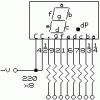Hi all, I'm new to electronics and recently purchased myself some basic equipment in order to begin experimenting with it because I want to make a hobby out of it. One of the things I bought was a seven segment display from radio shack. Part number 276-075. I tried to hook it up according to the information on the back but was unsuccesful. I thought perhaps I could post the information they give on the package and tell you guys how I interpreted it and then you could tell me where I've gone and how I could correctly wire it.
First off there are 10 pins on the display. They are marked as follows on the back of the package. (the package lists 4 non-existent pins as no pin).
1. Anode F
2. Anode G
3. No pin
4. Common Cathode
5. No pin
6. Anode E
7. Anode D
8. Anode C
9. Anode RHDP
10. No pin
11. No pin
12. Common Cathode
13. Anode B
14 Anode A
It also lists some maximum ratings as follows.
Forward current: 30mA
Forward Voltage: 2V
Reverses Voltage: 5V
Power dissipation: 100mW
Here's how I interpreted this information. I decided that the common cathodes must hook up to the positive voltage of the batery permanently. I assumed the way the display would work is the cathode pins would be permanently connected to the positive voltage and then segments on the display would light up corresponding to which of the Anodes A through F were connected to ground. I wasn't sure what Anode RHDP on pin 9 meant so I thought that it might be a pin that has to permanently connect to the ground. So the set up I had was pin 4 and 12 connected to + voltage and pin 9 connected to ground. Then I tried connected the various other pins to ground in order to make them light their particular segment of the display. This however was unsucesfull. Can anyone tell me the correct way to to wire one of these things. If you could also explain the significance of the section that contain forward and reverse voltages and current I would appreciate it. I know that they dictate the maximum amount of current and voltage the part can handle but I'm confused as to what the forward and reverse mean. Thanks in advance.
First off there are 10 pins on the display. They are marked as follows on the back of the package. (the package lists 4 non-existent pins as no pin).
1. Anode F
2. Anode G
3. No pin
4. Common Cathode
5. No pin
6. Anode E
7. Anode D
8. Anode C
9. Anode RHDP
10. No pin
11. No pin
12. Common Cathode
13. Anode B
14 Anode A
It also lists some maximum ratings as follows.
Forward current: 30mA
Forward Voltage: 2V
Reverses Voltage: 5V
Power dissipation: 100mW
Here's how I interpreted this information. I decided that the common cathodes must hook up to the positive voltage of the batery permanently. I assumed the way the display would work is the cathode pins would be permanently connected to the positive voltage and then segments on the display would light up corresponding to which of the Anodes A through F were connected to ground. I wasn't sure what Anode RHDP on pin 9 meant so I thought that it might be a pin that has to permanently connect to the ground. So the set up I had was pin 4 and 12 connected to + voltage and pin 9 connected to ground. Then I tried connected the various other pins to ground in order to make them light their particular segment of the display. This however was unsucesfull. Can anyone tell me the correct way to to wire one of these things. If you could also explain the significance of the section that contain forward and reverse voltages and current I would appreciate it. I know that they dictate the maximum amount of current and voltage the part can handle but I'm confused as to what the forward and reverse mean. Thanks in advance.

